Zingerman’s: Making It Right for the HDC
Employees at Zingerman’s Deli – or any of the Zingerman’s family of businesses – are trained to handle complaints from customers with a five-step process. The third step: Make it right.
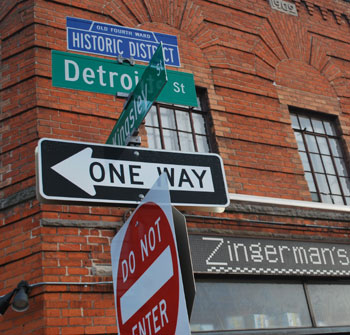
Plans to build an addition behind the brick Zingerman’s Deli building will ultimately require approval from the city’s historic district commission. (Photos by the writer.)
Zingerman’s itself is “handling a complaint” from the city’s Historic District Commission (HDC) – one that can be traced back to a June 2008 Zingerman’s request to demolish two houses, which are located in the city’s Old Fourth Ward historic district.
Now Zingerman’s is bringing back another proposal, but this time they’re not starting formally with the HDC. Instead, they’ll begin by seeking approvals from the city’s planning commission and the city council.
The site plan calls for a two-story, 9,500-square-foot structure to be added to the rear of the deli building, which will carry a price tag of around $4 million. The new building would replace the house at 322 E. Kingsley St. and extend lengthwise towards Community High School.
Zingerman’s started satisfying the formal steps for getting approval of their expansion project this week, on Monday, March 8, by holding a citizens participation meeting.
But Zingerman’s has also met informally with the HDC at two separate work sessions since the start of the year – one in January and the other on Thursday, March 11. Based on a significant change in design between those two meetings, which integrates “the orange house” into the project instead of demolishing it, Zingerman’s is trying to “make it right” for the HDC.
Still, at Thursday’s HDC work session, the Zingerman’s team stressed how great the challenges were – financial and logistical – to preserving the orange house as part of the project design. It seemed apparent that Zingerman’s was making an implicit pitch for members of the HDC to give a green light for the previously proposed project – the one minus both houses.
It was clear enough, in any case, that Jill Thacher – the city planning department’s historic preservation specialist – finally said towards the end of the meeting: “We’ve been over that. I want to keep you from going back to that.”
Background: Certificates, Notices, Zoning Change
In June 2008, the first step Zingerman’s took with their project was to request permission to demolish the two houses from the city’s historic district commission. This time around, Zingerman’s will first seek approval from the city’s planning commission and city council, and then ask for approval from the historic district commission.
Understanding the reason for ordering things differently this time requires a clear understanding of the difference between two notions: (i) a certificate of appropriateness; and (ii) a notice to proceed.
It’s also useful to understand how the zoning code has changed for part of the land since June 2008.
Background: Certificates of Appropriateness
The minutes from the historic district commission’s June 12, 2008 meeting show that the commission considered Zingerman’s application to demolish two houses – along with a garage – as an application for a certificate of appropriateness. This is one “flavor” of the kind of permission that the HDC can grant.
That application was brought before the HDC without a site plan or drawings to show what Zingerman’s planned to build there. What Zingerman’s had planned at that point was a 3-story new building, compared to the 2-story building that is now being proposed.
During the June 12, 2008 HDC public hearing on the matter, the lack of a presentation on their actual plans was a point on which Zingerman’s drew criticism. Responding to that criticism, Ken Clein, an architect with Quinn Evans who is working on the project, explained the absence of a specific site plan. From the HDC minutes of that meeting:
Applicant Rebuttal: Mr. Clein – [...] the fact that they are not presenting plans or designs to replace these structures with. It was at the suggestion of staff that we separate that issue from the issue for request for demolition.
The issuance of a certificate of appropriateness for work in an historic district depends in part on whether the building in question is a “contributing” or a “non-contributing” resource. A building that’s determined to be “non-contributing” is more easily altered than a building that’s “contributing,” under the Secretary of the Interior standards governing historic renovation.
A recent case of requested demolition in the Old West Side historic district – unrelated to Zingerman’s proposal in the Old Fourth Ward – highlighted the same issue of “contributing” versus “non-contributing” buildings. Permission to demolish two houses and a gas station on Second Street was sought by the developer of the Liberty Lofts project, to make it possible to construct additional parking spaces. He’d hoped that the potential for adding parking spaces would help attract a retail tenant for the still-vacant space in the greenhouse structure at First & Washington. [Chronicle coverage: "Demolition in Historic District?" and "Historic Commission: No Approval for Demolition"]
The HDC found the gas station – at the corner of Liberty & Second – to be non-contributing, but found the houses to be contributing. Commissioners voted to issue a certificate of appropriateness to demolish the garage, but wound up splitting 3-3 on all possible resolutions on the two houses.
Similarly, in June 2008 the HDC voted to issue a certificate of appropriateness for the demolition of the Zingerman’s non-contributing garage, but voted to deny the request to demolish the two houses, which commissioners found to be contributing to the Old Fourth Ward. While the HDC vote on the house at 420 Detroit St. was unanimously against demolition, the vote on the fire-damaged 322 E. Kingsley St. house was only 4-3 against demolition.
Background: Notices to Proceed
It seems impossible to reconcile Secretary of Interior standards for appropriate work in an historic district – one of which concerns “reversibility” of the work – with demolition of a building that the commission has determined to be a contributing resource.
However, another option to contemplate – a second “flavor” of permission – is that the HDC could issue a “notice to proceed.” The criteria for issuance of such a notice, from the city code, are as follows:
8:416. Notice to proceed.
(1) Work within a historic district shall be permitted through the issuance of a notice to proceed by the commission if any of the following conditions prevail and if the proposed work can be demonstrated by a finding of the commission to be necessary to substantially improve or correct any of the following conditions:
(a) The resource constitutes a hazard to the safety of the public or to the structure’s occupants.
(b) The resource is a deterrent to a major improvement program that will be of substantial benefit to the community and the applicant proposing the work has obtained all necessary planning and zoning approvals, financing, and environmental clearances.
(c) Retaining the resource will cause undue financial hardship to the owner when a governmental action, an act of God, or other events beyond the owner’s control created the hardship, and all feasible alternatives to eliminate the financial hardship, which may include offering the resource for sale at its fair market value or moving the resource to a vacant site within the historic district, have been attempted and exhausted by the owner.
(d) Retaining the resource is not in the interest of the majority of the community.
In the case of the recent request in the Old West Side for demolition, the Liberty Lofts developer argued that all of the criteria might apply, including (b). However, the commission – in consultation with the city attorney’s office – seemed ultimately to reject (b) as a possibility, citing the fact that the developer had no “planning and zoning approvals, financing, and environmental clearances” as required by (b).
And when Zingerman’s went before the HDC in June 2008, they also did not have planning commission or city council approval for the project.
With their current plan to obtain permissions from the planning commission and the city council first, before returning to the HDC, Zingerman’s would be in a position to make a case for alteration of contributing structures, based on criterion (b).
At the earlier public hearing in June 2008, Peter Pollack, a landscape architect who also lives near Zingerman’s Deli, laid out the case based on exactly that criterion. From the summary of Pollack’s remarks in the HDC minutes of that meeting:
[...] I ask you to put in context with the historic development of what has occurred on this property. Buildings have been relocated, reoriented and adjusted. This is in the same spirit of that reorientation and adjustment. If you look at the “Notice to Proceed,’ this is a major deterrent to an improvement program, and I say that this is exactly the case.
Background: Zoning
The Zingerman’s project that will be brought before the planning commission – probably in May – will be intended to meet all applicable zoning codes. That will make it a so-called “matter of right” project. That is possible due in part to a rezoning of the 322 E. Kingsley St. parcel, which took place last summer as part of the Ann Arbor Discovering Downtown (A2D2) rezoning project for all of downtown.
The previous zoning for 322 E. Kingsley St. was R4C, which is designated for residential, not commercial use. The new D2 zoning classification allows for various commercial uses, including restaurants and offices.
The rezoning of 322 Kingsley St. was given preliminary approval by the city council in April 2009 as part of a comprehensive rezoning of downtown Ann Arbor. That required review of the change by the planning commission, which ultimately approved it, in connection with its revision of the city’s downtown plan.
The 322 E. Kingsley St. rezoning was controversial for the planning commission, passing on a 4-3 vote. From The Chronicle’s report of the May 19, 2009 planning commission meeting, when the revision was approved.
During the public hearing, the planning commission heard from several speakers who objected to the assignment of the D2 designation to the property, on the grounds of “fairness” and “favoritism” – everyone loves Zingerman’s, themselves included, they said. But that didn’t translate into changing the zoning, just because Zingerman’s asked for it.
They also heard from representatives of Zingerman’s about why the D2 zoning was requested, as well as from a speaker who noted that he’d just witnessed two hours of “serious participation” by citizens who were engaged, and had been properly noticed, and concluded that the notion of fairness had not been violated.
The vote on the commission was 4-3 for following council’s lead in assigning D2 zoning to the parcel. Voting for the D2 designation were: Eric Mahler, Tony Derezinski, Jean Carlberg, and Wendy Woods. Voting against it were: Bonnie Bona, Kirk Westphal, and Ethel Potts. Mahler, responding to an argument made by Peter Pollack at the previous week’s work session, said that the option of pursuing a PUD for a particular project (as an alternative to having the D2 zoning) would, in his opinion, be difficult. For a PUD, Mahler said, a public benefit would have to be demonstrated – and from what he could tell, the kind of project Zingerman’s was contemplating would most likely be for Zingerman’s benefit.
Westphal did not cite “fairness” in voting against the D2 designation, but rather a respect for the long, extended process of community participation that had extended over a few years – none of which had included discussion of the 322 E. Kingsley parcel.
Background: Timeline Overview
- June 12, 2008: Historic district commission denies request for demolition of 322 E. Kingsley St. and 420 Detroit St. [Rocco Disderide's former residence, aka "the orange house."]
- Feb. 19, 2009: Planning commission adopts downtown plan with various revisions but no change to existing R4C zoning of 322 E. Kingsley St.
- April 6, 2009: City council gives initial approval to zoning revisions to downtown requiring alterations to the downtown plan adopted by the planning commission; major alterations include changes in South University area, but also included a rezoning of 322 E. Kingsley St. from R4C to the new D2 classification. The amendment on 322 E. Kingsley St. is introduced by Sandi Smith (Ward 1) and passes with dissent only from Sabra Briere (Ward 1). [link]
- May 19, 2009: Planning commission approves revisions to the downtown plan to accommodate part of the city council’s South University zoning revisions, an East Huron zoning revision, and the 322 E. Kingsley St. revision. [link]
- June 15, 2009: City council adopts downtown plan as revised by the planning commission. [link]
- Nov. 16, 2009: City council gives final approval to downtown zoning revisions, including the D2 designation to 322 E. Kingsley St.
- Jan. 14, 2010: At an HDC work session, Zingerman’s presents plan showing demolition of two houses.
- March 8, 2010: Zingerman’s holds a public participation open house on its proposed expansion.
- March 11, 2010: At an HDC work session, Zingerman’s presents a plan showing demolition of one house only.
Zingerman’s Expansion: January 2010 HDC Work Session
The city’s historic district commission typically conducts its work sessions just after its regular meetings conclude – in the city council workroom, which adjoins the council chambers where the commission holds its regular meetings.
At the Jan. 14, 2010 HDC work session, Ken Clein of Quinn Evans Architects was joined by Gary Bruder, Zingerman’s legal counsel, and Nancy Rucker, who works in Zingerman’s Deli operations.
Clein presented the project with conceptual drawings and a study model – which at that time showed the removal of both the 322 E. Kingsley St. house and the 420 Detroit St. house.
Clein explained that the proposal to expand was related to an interest in preserving the original historic deli building. The current cooking and dishwashing operations in the building, he explained, generated moisture that escaped through the exterior brick, and caused deterioration of the wall. The evidence of the toll that it takes, he said, can be seen on the exterior of the wall facing Kingsley in the form of efflorescence – white salt deposits.
Clein also outlined a number of challenges associated with the Zingerman’s campus, one of them the seven-inch elevation change, which has an impact on what’s required to meet ADA accessibility standards, as well as the tight quarters, which has an impact on where stormwater detention can be undertaken.
The key issue for commissioners, naturally, was the question of removing both houses. Generally, commissioners did not seem wed to the idea of preserving the 322 E. Kingsley St. house.
[The June 2008 vote on that house had been close: 4-3 against demolition. One of the votes against demolition was Michael Bruner, who has since been replaced on the HDC with Patrick McCauley. McCauley's comments at the work session suggest he could be supportive of removing the 322 E. Kingsley St. house.]
On the 420 Detroit St. house, however, McCauley was unambiguous: “I’ll just come out and say it. I don’t think you should tear that house down.”
What McCauley pointed to was the fact that the proposed new building seemed to impinge on just one corner of the house, and for that reason, he did not think the condition was met that the removal of the house be “necessary.”
Clein countered by saying that there was more to it than just the small corner of the house. Among the specific issues he enumerated were: the impact on accessibility and the need to construct ramps; plus proximity of the house to the new structure triggering a requirement of fire-proof sheathing, which added to the expense; and the need to temporarily move the house to accommodate the actual construction of the new building.
Key for Clein was the idea that if cost were no object, then anything was possible – but it was a matter of how much cost was reasonable to ask of someone in order to rehabilitate an historic property.
On the question of expense, commissioner Diane Giannola wondered what the cut-off was for rehabilitation being “too expensive.” She allowed that it was “something to think about.” On the cost question, McCauley contended that it was only a small part of the overall project budget. Clein countered that in ballpark numbers, the rehabilitation of the house would likely be $0.5 million out of a project budget of $3.5 million to $4 million – or 1/7 of the budget, which he did not consider to be a small part of it.
Giannola raised the question of whether the 420 Detroit St. house could be seen from the street, to which McCauley responded: “You can totally see it from the street!” Giannola maintained that it was not a part of the streetscape, but noted that it was still a part of going to Zingerman’s Deli.
On the topic of location, Jill Thacher, the city planning department’s specialist in historic preservation, addressed the topic of the house’s history. It had been moved from the corner where the brick deli building now stands, she said, but that was during the district’s period of significance. This meant the fact that it had been moved was not an argument that it wasn’t a contributing structure. “Let me get the ‘it’s been moved’ argument off the table,” she said. [The same issue had been discussed fairly thoroughly at the HDC's June 2008 meeting.]
Commissioners discussed how far the notion of “necessity” in the criteria for a notice to proceed extended – was it “necessary” that Zingerman’s undertake the expansion at that location?
Commissioner Ellen Ramsburgh wondered if the expansion was more than the site could take. She noted that the Zingerman’s Creamery and Bake House had moved to peripheral locations. “Do you need to be there?”
In her remarks, Ramsburgh was echoing sentiments expressed by then-commissioner Michael Bruner back in June 2008, when he had made the suggestion that Zingerman’s think of moving their operations. The specific location he had in mind was the Old West Side structure adjoining the Liberty Lofts development:
Commissioner Bruner – [...] This may be less than what they need, but there stands today, a project that we reviewed and was approved, a development that includes a 20,000 square foot commercial retail area with parking that is begging to be occupied. [An apparent allusion to the Liberty Lofts greenhouse building.] As preservationists that want to encourage the success of economic projects in the city, perhaps Zingerman’s should consider moving their location as they have with their Creamery, which is at a satellite location, their Bakery which is at a satellite location, their Roadhouse that is a satellite location – this could be relocated as a satellite component at another location, nevertheless retaining this location as it is.
Clein responded to Ramsburgh at the January 2010 HDC working session by wondering if there were another historic district in another town where Zingerman’s could contemplate locating their operations. Ramsburgh: “That’s a threat!”
Zingerman’s Expansion: March Public Meeting, HDC Work Session
At the open house event held on March 8 to introduce the new project to the public, a key difference in the plan was apparent, made since the January HDC work session: The 420 Detroit St. house – “the orange house” – is now incorporated into the design, both in the drawings and the study model.

HDC work session, March 11, 2010. From the far end of the table, at right, going clockwise: Paul Saginaw, Lori Saginaw, Lesa Rozmarek, Kristina Glusac, Diane Giannola, Ellen Ramsburgh, Nancy Rucker, Gary Bruder, Bill Kinley, Deb Cooper, Ken Clein, Jill Thacher, Patrick McCauley, Rick Strutz, Grace Singleton.
At the open house, Ray Detter, president of the city’s downtown citizen’s advisory council, responded to a mention that the plan now included “the orange house” with the clarification: “You mean the Disderide house?”
Rocco Disderide was the proprietor of a grocery in the brick deli building, who moved the house from the corner to make way for that building.
Detter had told the board of the Downtown Development Authority at their last meeting, on March 3, 2010, that the advisory council was concerned about Zingerman’s plan to expand:
Zingerman’s plan generated “heated discussion” at DCAC, said Detter. The deli is located in the Old Fourth Ward historic district. He said they agreed that Zingerman’s is an essential part of the community, but that they needed to make sure there’s not a precedent set that would undermine planning. The decision needed to be oriented around the city’s planning documents: the downtown plan, the central area plan, and the historic district.
At the March 11, 2010 HDC work session, Ken Clein mentioned that some of the attendees of their March 8 open house were puzzled as to why they were keeping the 420 Detroit St. house as a part of the design.
As a designer and an architect, Clein said, he did have some concern for the judgment of history – would people look back 50 or 100 years from now and wonder why that house was incorporated into the design? “Will they look back and say, ‘What the …? Stupid preservationists!’” Patrick McCauley joked in response: “They’re going to say that anyway!”
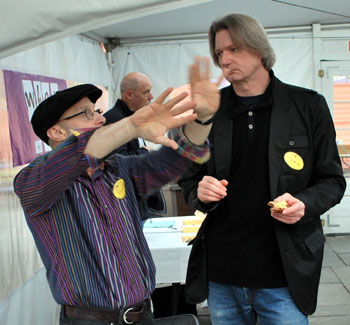
At the March 8 open house, Paul Saginaw, a founding partner of Zingerman’s, is not explaining how he fought his way through the curds, swimming to the surface after falling into a vat of cheese. He’s explaining to a neighbor how the Zingerman’s project is going to look.
The question of how much the preservation of the 420 Detroit St. house would cost arose again, just as it had at the January work session. In the interim, some more concrete numbers had been attached to the cost of rehabilitating the house for integration into the design. The house is shown in the design to be attached to the building at the rear via a glass connector.
Bill Kinley, who owns Phoenix Contractors Inc., was at the work session on Zingerman’s behalf to provide comment on some of the construction costs. McCauley was skeptical of the costs shown for electrical upgrades to the structure, citing some familiarity with the cost of a complete electrical replacement of a house. Kinley pointed out that there’s a rule of thumb for residential rewiring of $30-$35 per opening (switch plate or plug) versus a $120-$140 rule of thumb for work to bring things up to commercial code.
The code requirements that the 420 Detroit St. house would need to meet are commercial standards.
Clein reported that the kind of work that would be necessary, and which Zingerman’s had now had estimated in more detail, included a rebuild of the foundation, new floor framing for the first floor, new joist hangers for the second floor and the addition of exterior sheathing. [The house is built with the balloon-frame construction technique.]
The additional cost of the project attributable to the rehabilitation of the 420 Detroit St. house would be between $600,000-$750,000. In terms of cost per square foot, Clein said, it came out to $572/sq. ft. By comparison, the new construction cost of a laboratory building at the University of Michigan – the Biomedical Sciences Research Building – was $100/sq. ft. less, at $480/sq. ft., Clein said. Kinley added that the new construction of a recent project that Phoenix had completed – the Towsley Children’s Center at Forest & Willard – came in at only $300/sq. ft.
Commissioners pointed to the importance of retaining the spatial relationships between the 420 Detroit St. house and the other buildings in the compound. At their regular meeting just before the work session, they’d turned down a request to add a second story to a 1-story garage, partly on the basis of those spatial relationships.
Picking up on this need to preserve the spatial relationships, Kinley suggested that they could simply rebuild the 420 Detroit St. house anew and replace it with new construction that would have the same shape and massing of the old house. Clein pointed out to the commissioners that with all of the work that would be required on the house to bring it up to code, there would likely be little of the original “fabric” of the house remaining.
Commissioners seemed cool to the implicit pitch that the Zingerman’s team was making to go back to a scenario where both houses would be demolished. Said Jill Thacher: “We’ve been over that. I want to keep you from going back to that.”
Commissioners also took care to stress that they were really happy with the proposal that removed the 322 E. Kingsley St. house but integrated the 420 Detroit St. house into the design, characterizing it as a good compromise. “I really like this,” said McCauley, allowing that he had been “the most strident person about the preservation of the orange house.”
On the fact that Zingerman’s had taken their feedback and incorporated it into their new proposal, McCauley summed it the contrast between the HDC’s experience with some applicants: “This is much preferable to getting yelled at.”
The current schedule calls for the proposal to come before the city’s planning commission in May. In the meantime, the Zingerman’s team will meet with the city’s building inspector on code issues related to the 420 Detroit St. house.

A rough study model of the area as it currently stands. The view is from the north. Detroit Street runs from front to back. Kingsley runs left and right. The Zingerman’s Deli brick building is on the corner of Detroit and Kingsley.
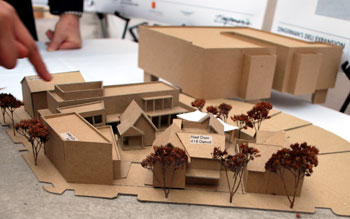
A study model of the Zingerman’s expansion viewed from Detroit Street, looking east. The finger is pointing at the screening for mechanicals on the roof of the proposed new building.
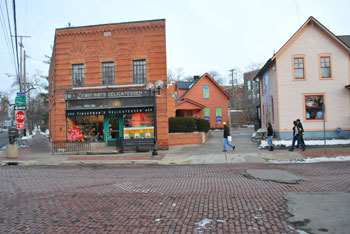
The Zingerman’s Deli building viewed from Detroit Street. The 420 Detroit St. property is the orange house to the right of the brick deli building.




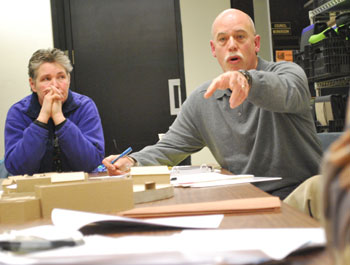

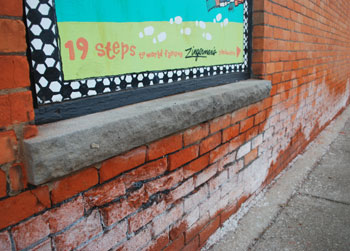
The energy (and time, and money) consumed by this long-running debate could really be put to much better use in so many ways.
Let Zingerman’s do what they need to! You would be hard-pressed to find a firm more supportive of the town’s values. I do think they are entitled to special treatment.
Thanks for your (as usual) complete and thoughtful coverage of this complex question and process. It reminds me of the service all our volunteer committee and commission appointees do for us. We expect them to be thoughtful, careful, and to follow the laws and regulations that they are expected to enforce. Certainly the council and administration are not able to provide this level of oversight. They receive little reward other than the satisfaction of knowing they have done a task necessary to the orderly function of local government.
The suggestion that any corporate entity (or person) should be above the law is troubling. The next question would be, who decides on the membership of that privileged group who are so deserving that our laws and regulations – and the open process that is supposed to be available to all – should be bypassed in their favor?
The HDC embodies everything that is wrong with the city. Here’s a thriving business wanting to expand. It wants to demolish some old, rundown buildings to do so. And city officials who are above the law, the voters, everyone, are making that process difficult.
More evidence that some want to keep Ann Arbor encased in amber.
If the laws and ordinances we have don’t support a “no-brainer” decision like this one, they something is wrong and they should be re-written so that this would not be illegal.
I read with great interest the article last week about Sabra Briere’s use of online survey tools to gauge the mood of her constituents. I think this was fantastic even if imperfect.
I suspect that if the city ran an online poll for city residents on this issue, 85% or more would support Zingerman’s.
we aren’t a narrow and rigid and dumb city, are we?
That orange building is true historic crapola.
I care much more about easy accessibility, reasonably affordable handicap access.
I much prefer that Zingermasn re-invest the 600-750 K for something of value to the business, the neighbors and the community.
The history worth preserving is what Zingerman’s has created at this corner…to the benefit of the Fourth Ward, Kerrytown businesses and the whole freaking community.